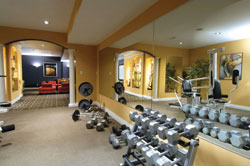 Over the past 20 years, the basement recreation rooms where Boomers misspent their youths watching American Bandstand?have “morphed into finished lower-level entertainment areas with game rooms, bars, dedicated home theaters and second family rooms,” says John Oldfather, a broker associate with ERA Kepple
Over the past 20 years, the basement recreation rooms where Boomers misspent their youths watching American Bandstand?have “morphed into finished lower-level entertainment areas with game rooms, bars, dedicated home theaters and second family rooms,” says John Oldfather, a broker associate with ERA Kepple
Billiard parlors and mega-TVs, however, are just the tip of the iceberg when it comes to what’s happening underground. Guest suites, exercise rooms and home offices are becoming increasingly commonplace, Oldfather says, while Victory Home Builders’ Renotta Henson lists elaborate nightclub settings with dance floors, sound studios, off-season clothes closets and walk-out gardening rooms among her clientele’s requests. Other area builders and remodelers cite darkrooms, hobby rooms, pool changing areas and temperature-controlled wine cellars. And for true sports enthusiasts, there are half-sized basketball courts, climbing walls, firing ranges and even basement bowling alleys.
The spotlight on subterranean living has profoundly changed the American basement, Henson observes. “People are opting for higher ceilings – nine feet or more,” she says. For Stonecroft Homes, 10 feet is the norm, says co-owner David Lutes, and some clients are going taller to accommodate floor plans with multiple levels.
Where flat land was once prized for home sites, in today’s new subdivisions, sloping lots command the premium prices, says Oldfather, who explains, “It’s much easier to build a walkout lower level on a slope.” Advantages of a walkout over a traditional basement include more natural light so the area feels less like a basement; a separate backyard entrance so guests don’t need to track through the entire house; and the ability to have a bedroom on the lower level without putting in a special “egress” (escape) window. Last but not least is resale value. Finished walkout basements appraise higher than regular finished basements, says Oldfather.
Unlike the upstairs, where women t/files/storyimages/to take control, the man of the house is much more involved with what goes on below, observes Lutes. “Guys get excited about the lower level. Some of them even refer to their basements as ‘man caves,’” he says. High on their wish lists are pub-style bars; separate men’s and women’s bathrooms, with a urinal in the men’s; and a game area equipped with pool and poker tables. “They want to re-create that neighborhood-bar feel,” he explains.
As home improvement projects go, basement remodels offer reasonable returns on investment, says Remodeling Online’s 2006 Cost vs. Value Report. Homeowners can expect to recoup about 78.8 percent of a mid-priced, $57,000 basement remodel when they sell their homes.
From the Top
Before considering a basement finish, check to make sure the ceiling is high enough to meet the seven-foot building-code requirement. Furnace and air-conditioning ducts can sometimes be broadened and rerouted to help with ceiling height.
 |
A basement bath that could pass for a master. |
If a lower-level bedroom is on the wish list, plan for an egress window, says Jeff Davis of Paul Davis Restoration & Remodeling’s Louisville branch on South Floyd Street. “That requires cutting into the foundation and installing a large window-with-a-well escape system,” he explains. “Although it’s only required for bedrooms, it’s a good idea if your kids are going to play down there.”
Code also requires that furnace rooms be a minimum of 85 square feet. Otherwise, louvered doors are required for airflow, Davis says.
Other recommendations he routinely makes for finished basements include:
• Install a sump pump with a battery backup.
• Put a backflow prevention valve on the waste-water pipe.
• Place your washing machine in a catch-pan in case of leaks.
• Make sure your contractor includes access panels for the water mains, electrical boxes and exterior water spigots. Code also requires that gas-line valves and electrical junction boxes be accessible.
Stairs are another important consideration, partially for aesthetics sake, says Henson. “Putting a glass door at the top and keeping the stairway open on at least one side prevents you from feeling like you’re going down into a cellar.”
Enclosed stairways can also make it impossible to fit your furniture down the steps, Davis observes. “You need to leave at least four or five treads exposed at the bottom,” he says, “to be able to make that turn for a couch.”
A final piece of advice: Don’t skimp on lighting. Henson says recessed lights, pendants over bars and wall sconces work best. “Use a lighting designer,” she advises. “The right lighting makes all the difference in the world.”
Alternatives to Drywall
Insulation maker Owens Corning rolled out its aptly named Basement Finishing System in 1998 after spending two years developing a product for the damp, cool conditions below grade, says Mike Jacobs, general manager for Certified Home Improvements on Decimal Drive. “Their major concern was mold. Basements stay at perfect temperature for mold to grow,” he explains, adding that traditional materials such as wood studs and paper-backed drywall and fiberglass insulation provide it with an excellent food source.
The Owens Corning system is made of mold- and mildew-resistant, 2?-inch-thick fiberglass panels covered with a tough, polypropylene fabric. The panels are mounted on tracks and can be popped in and out — a major advantage should water problems develop, Jacobs says, noting that lower levels are prone to water damage from upstairs plumbing leaks, groundwater seepage, malfunctioning sump pumps and sewer backups. “You can take out an entire section of wall in just a matter of minutes, allow it to dry, clean it and put it back up,” he says. “Drywall would be totally ruined.” The track system also keeps foundation walls, plumbing and wiring easily accessible, he adds.
This lower-level rec area accommodates much more than a billiard table.
Other advantages include its R-11 insulation value, making it eligible for an Energy Tax Credit of up to $500 if installed by Dec. 31, 2007; fast installation (most basements can be finished in just two weeks, Jacob says); great acoustics for home theaters, since it absorbs 75 percent of the sound in a room; and its Class A fire rating.
On the negative side, the system’s finished walls look very different than the rest of the house; the panels come in only one color; and mending plates are required for hanging pictures on the walls. Wall-mounting a flat-screen TV requires special measures, but can be done.
Advice for New Homes CERTIFIED HOME IMPROVEMENTS VICTORY HOME BUILDERS PAUL DAVIS RESTORATION & REMODELING STONECROFT HOMESResource List
11341 Decimal Drive, 297-8181
7025 W. Highway 22, 241-0215
945 S. Floyd St., 583-1668
8811 Duck Crossing Lane, 523-7041
If you’re building a new home and plan to wait awhile before finishing the basement, Henson, Davis and Jacobs offer the following tips:
• Decide on the lower level’s floor plan before you start digging the foundation. Your builder or architect can change the location of load-bearing walls and columns to accommodate what you want in the future. “It’s especially important to know where your openings will be,” Henson says.
• Rough in the plumbing for bathrooms and wet bars at the time you build, Henson advises. “Otherwise, you’re looking at jackhammering the basement floor down the road.”
• Don’t wait to insulate your basement walls and ceiling. Do it while you’re building.
• Make sure your electrical service is sized to accommodate your future needs, says Davis. “Otherwise, you may have to upgrade your panel box.”
• Place your water heater and furnace on a perimeter wall rather than in the center of the basement, Jacobs recommends.


